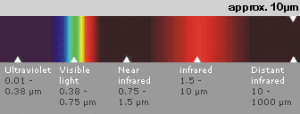Home Page › Technical information › Infrared information
Infrared information
Infrared information – The facts
Here we look at the history of infrared, the principle behind how infrared works and how we can feel this for ourselves in nature from the sun, this feeling of warmth also has a healthy effect on the workings of our bodies.
- When was infrared discovered?
- What is the technology behind the surface?
- How does infrared work?
- Natural infrared in nature.
- The health benefits of infrared heating.
- Creating a comfortable working environment.
When was infrared discovered?
 Infrared radiation was discovered as long ago as 1800, when an English astronomer discovered the existence of infrared energy beyond the red end of the visible light spectrum. He found that when sunlight was passed through a glass prism it formed a spectrum, if a thermometer was then moved along the spectrum of colours the heating effect could be monitored, moving the thermometer beyond the red end of the spectrum where no light was visible the heating effect increased. This new region of the electromagnetic spectrum was called the infrared.
Infrared radiation was discovered as long ago as 1800, when an English astronomer discovered the existence of infrared energy beyond the red end of the visible light spectrum. He found that when sunlight was passed through a glass prism it formed a spectrum, if a thermometer was then moved along the spectrum of colours the heating effect could be monitored, moving the thermometer beyond the red end of the spectrum where no light was visible the heating effect increased. This new region of the electromagnetic spectrum was called the infrared.
Near infrared is now commonly used in patio heaters that give off an orange light glow, our panels use far infrared which has no visible colour or light. Only rays which fall into the 0.75 to 15 microns do the heating, the most efficient spectrum for heating is 6 to 10 microns, in tests our panels produce 99.82% of its output from the far infrared range and more than 90% in the optimum spectrum range.
What is the technology behind the surface?
Infrared heating panels have been available in Europe for a number of years, the technology has rapidly improved to create a more efficient product, especially now that fuel prices are increasing and consumers are more energy conscious.
Our panels use a patented formula of a very high grade Carbon Nickel mixture developed by Austrian technicians and Nano Silver conductors developed by the Japanese, all coated by a dielectric layer. A unique reflector technology emits all rays to the front of the panel although the back may feel hot.
The excellent efficiency levels of our panels is achieved by reaching the optimum spectrum area with little wattage input to the surface area to reach optimum surface temperature. If viewed with a thermal imaging camera our panels will have an even distribution of heat.
How does infrared work?
Wavelengths found in both the near and far infrared range of the spectrum will create the energy required for atoms within an object to start vibrating, this process can only take place when the energy presented is of the correct form. Vibrating atoms in an object will cause it to heat up, their vibration energy can be transferred between atoms in the object and the surrounding atmosphere. An atom absorbing infrared energy will convert it into an increase in its own vibration and therefore an increase in heat, this heat usually can be readily taken over by other atoms. At the other end of the spectrum wavelengths from the ultraviolet or X-ray areas create little or no heat.
Infrared heats people and objects directly without the need to heat up the air in between unlike convection heaters that primarily work on heating the circulating air. Infrared rays warm the skin, the heat is then passed by the blood circulation around the body. People will feel an even comfortable warmth whilst the surrounding air may be cooler. The infrared rays are also warming the walls and objects within the room too, maintaining a warm room is key to energy efficiency so working in conjunction with good insulation our panels can be left on a low thermostat throughout the day to create a warm and comfortable environment.
Natural infrared in nature.
When infrared rays touch a surface they will cause it to heat up, the most common example of this is sitting in the sun. The suns infrared rays will provide healthy warmth on the skin irrelevant of the outside temperature, you may even be enjoying the sunshine whilst in the snow on a skiing holiday. A warm sunny wall is also the result of the suns infrared rays this time heating the stonework which in turn radiates the heat back. Every object that is warmed will radiate some electromagnetic heat radiation back, the intensity of the radiation increases as the vibration of the atoms in the object increases.
The health benefits of infrared heating.
Infrared heating has clear health benefits over convection heating. We have already talked about the movement of heat around the body through optimum blood circulation this creates deep warmth throughout the whole body and is not limited to the surface as with convection heaters. Infrared heating does not cause air currents or movement of dust which can cause problems for people with asthma or bronchial ailments. Still and dust free air is far more pleasant for users of contact lenses and people suffering with rheumatic pain will find the homogenous humidity may reduce their pains. Air that is humidity stable and dust free combined with the silent operation of these heaters will all work together to provide a generally better working or living atmosphere.
Relative humidity is also an important feature here, comfortable air conditions rely on the fact that perspiration needs to be easily released into the atmosphere, perspiration helps transport body heat and keeps our body temperature stable. For water to evaporate heat is required, this is supplied by the body. Relative humidity is the amount of water vapour in the air relative to the maximum amount of water vapour the air can contain. Relative humidity decreases as the air temperature rises, therefore more comfortable air conditions are felt at lower temperatures.
Relative humidity and temperature can be kept constantly stable across the entire room heated by infrared making a better working environment. However in a room heated by convection the air is moving up and around, the temperature and relative humidity vary from the floor to ceiling and from close to the heater to the farthest end of the room. It is this temperature curve that keeps the convection going but also creates air and dust movement and hot scorched air and cold spots.
Ventilation is essential for a healthy and comfortable working atmosphere, any new heating system must take into account the financial costs of heat loss through ventilation. Convection heaters work with higher air temperatures and rely on the movement of air causing a significant waste of money in heating air to be lost through an open window, however infrared heating is directly heating the people and objects combined with no movement of air the losses will be far less. Infrared outdoor heaters, often used outside pubs or restauants, are an energy efficient way of heating people outside because the heat is felt directly on the skin even though the outside air may be very cold.
Creating a comfortable working environment.
Our quality infrared heaters are designed to provide you with comfortable heating and healthy working atmosphere whilst being energy efficient and easy to install. We do recommend that to provide optimum benefits other environmental conditions should be taken into account.
The human body works at its best in an optimum environment, where by heat can easily be absorbed, produced and released by the body and where air is fresh and clean. Body heat comes from processes such as metabolism and from the organs and muscles, the heat each produces varies according to the work load involved, but our bodies do need to regulate heat. There is a very small comfort zone whereby heat is balanced within the body.
Our bodies are constantly working and creating heat which radiates to warm our environment, this may be less in a sedentary person than one in physical work, so we are able to help regulate body temperature by a number of other means, appropriate clothing and still air insulates the body and the use of direct heat from infrared heaters will help to prevent heat loss from the body and keep a balance. Heating a room isn’t simply to heat the body but more to combat heat loss. The body produces heat in standard use of 200 to 240 watts per metre ², a person sitting quietly may only produce up to 160 watts/m² and will require extra direct heat to maintain comfort, however a person in physical exercise may produce up to 280 watts/m² and will require a lower room temperature and lower humidity to allow for perspiration, evaporating water into the surrounding air.
If room temperature increases too high above our comfort zone perspiration will happen to balance the body temperature by evaporating the water away, if room temperature continues to increase our body cannot balance itself and body temperature will increase.
If room temperature decreases the body will gradually lose heat, goose pimples create an air insulation layer and reduced blood circulation in the skin helps combat heat loss. Shivers are caused by muscular contractions to create activity in the body and therefore extra heat arises.
A comfortable heat is generated by a number of conditions, firstly by even air temperature, constant relative humidity, little movement of air and heat radiation from objects, there are other variables to take into consideration such as the physical work load and appropriate type of clothing worn.
A comfortable environment is one where the body can balance its own temperature with that of the environment.



